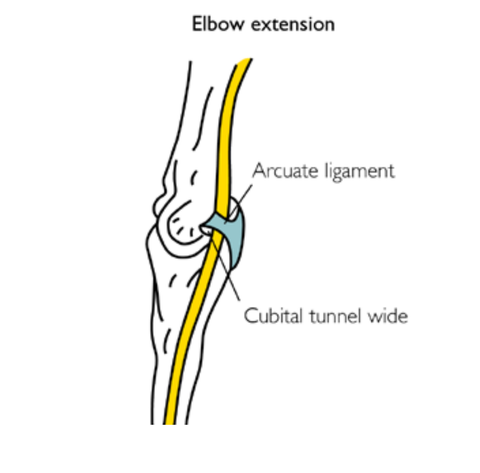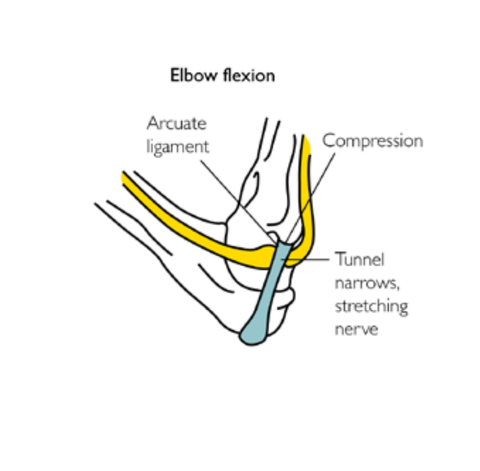Cubital Tunnel Syndrome

Cubital Tunnel Syndrome (CTS) is a condition that affects the nerves of the upper extremity. It can cause pain, tingling, and numbness in the hand. In some more severe cases left not treated, it can lead to long-term damage to the hand.
Treatment for CTS is mainly a matter of controlling the symptoms. In severe cases, surgery may be necessary. For mild cases, conservative treatments are recommended and there are a wide variety of natural alternative therapies that can be safely applied and may prove effective. Treatment goals are to reduce pain and paraesthesia whilst the patient avoids activities that put extra pressure on the elbow.
A splint or a brace can be worn to help with this. If conservative treatments do not work over time or symptoms become worse, you should visit your physician for medical diagnosis and advice.
The first step in cubital tunnel syndrome treatment is to identify the cause of the problem. Your doctor will do a physical exam and take a detailed medical history. He or she will then determine the severity of your symptoms. They will also check for other medical conditions that may be causing them.
Once the causes are identified, your doctor can recommend nonsurgical or surgical treatment. The most common conservative treatment is a splint.
Other methods of treatment include medication and therapeutic ultrasound. While the use of therapeutic ultrasound is a good option, it is important to be careful. This is because it can damage the nerve.
There are several surgical options employed for cubital tunnel syndrome surgery. Some surgeons remove the bump on the inner elbow where the ulnar nerve passes. Others perform surgical decompression.
Generallyspeaking, surgical intervention should be avoided if possible. In addition to physical therapy, your physician may also recommend natural, alternative therapies including massage, manual therapy, dry needling, acupuncture, and many others.
When exploring conservative treatments, it is most important to consider the specific training and experience of the therapist or practitioner. There will be for example massage therapists who have rarely if ever treated CTS whilst there will be others (perhaps those who have worked in throwing sports) who will have tremendous expertise in the treatment of the condition. Always do your homework online and interview your proposed therapist with a prepared list of questions!
Cubital Tunnel Syndrome (CTS) is sometimes known as “funny bone” syndrome, but there is nothing funny about a traumatized Ulnar nerve
The Ulnar nerve is one of the three key nerves supplying sensation and power to the arm, wrist, and hand.
The Ulnar Nerve is positioned in a slightly vulnerable position in the Cubital Fossa, where it can become traumatized; even sitting and leaning elbows on armrests or a desk can be enough to do this.

Any intense physical activity that adds pressure to the nerve can cause CTS, sometimes including abnormal bone growth in the elbow region.
CTS (Ulnar Neuropathy) is a condition that is caused by compression to the ulnar nerve, often by connective tissue or bone but sometimes functionally by trigger points (especially in the Flexor Carpi Radialis and Ulnaris) muscles.

When a trigger point develops, the host muscle becomes shorter, thicker, and less efficient. Because muscles are made up of 75% water and water does not compress well, they become functionally swollen, which often leads to a taut band that can have further pressure effects on local tissues.
Any change in shoulder, wrist, or elbow mechanics over time may manifest in areas of tight muscles where trigger points may develop.
Women have a slightly different elbow anatomy to men. In men, the arms are straighter; women have a larger “carrying angle” to avoid bumping their hands into their wider pelvis.
Women also have 2-19 times more fat content on the inner elbow overlying the funny bone prominence (the ulnar coronoid process). This larger carrying angle seems to reduce the incidence of CuTS. CuTS is 3-8 times more common in men.

Rehabilitation Exercises For Cubital Tunnel Syndrome
If you have cubital tunnel syndrome, you may be experiencing pain and numbness in your hand. These symptoms occur when the ulnar nerve is compressed inside the cubital tunnel. This nerve is the second most common nerve to be compressed in the arm. It is found near the ulna bone, and is used to provide sensation to the ring and pinkie fingers. A physical therapist can help you determine the cause of your symptoms and design a treatment plan that will improve your condition.
There are several at-home treatments that may help relieve your symptoms of cubital tunnel syndrome. Some of the common methods include exercise, ice and nonsteroidal anti-inflammatory medications. In addition, surgery is also an option. The goal of surgery is to alleviate pressure on the ulnar nerve, which can reduce symptoms.
Physical therapists have the ability to teach you how to perform exercises that will help your body heal. They can also teach you to avoid positions that can worsen your symptoms. For example, if you bend your elbow while sleeping or using your computer, you can rest your elbow on an armrest instead. Similarly, if you frequently sit in a low chair, you should avoid this position.
The most important aspect of cubital tunnel syndrome treatment is to avoid activities that aggravate your condition. This may mean not working or taking a break. Using a rigid elbow brace can help to reduce pain and swelling. Similarly, avoiding vibration-producing tools can also decrease your risk.
You should also avoid the use of vibratory devices and other tools that require you to flex your elbow. This can place unnecessary pressure on the ulnar nerve. To avoid these risks, you should also try to reduce your weight. While obesity has been linked to cubital tunnel syndrome, other risk factors are unknown.
Physical therapists can also teach you ways to prevent further injury to your arm. For example, if you are an athlete, you should make sure you do not over-exert yourself. Also, you should not use vibratory devices for long periods of time. Likewise, you should try to avoid positions that can increase the pressure on the ulnar nerve, such as bending your elbow for long periods of time.
Medication and Surgery
You can also use a steroid injection into the cubital tunnel to alleviate your pain. Alternatively, you may choose to have a medial epicondylectomy, which involves removing a part of the bump in your elbow. When a medial epicondylectomy is performed, the nerve will be less irritated. However, this method has the potential for further nerve damage.
Your therapist can also help you develop a customized postsurgical physical therapy program to help you regain your full range of motion. They can also assist you in developing a stretching program that is safe for you. By incorporating stretches into your rehabilitation routine, you can minimize your risk for further injury.
If you have cubital tunnel syndrome, the key is to do as much as you can to improve your condition. Although a physical therapist can help you achieve a successful outcome, it is up to you to practice what they have taught you.
This blog is intended to be used for information purposes only and is not intended to be used for medical diagnosis or treatment or to substitute for a medical diagnosis and/or treatment rendered or prescribed by a physician or competent healthcare professional. This information is designed as educational material, but should not be taken as a recommendation for treatment of any particular person or patient. Always consult your physician if you think you need treatment or if you feel unwell.
About Niel Asher Education
Niel Asher Education (NAT Global Campus) is a globally recognised provider of high-quality professional learning for hands-on health and movement practitioners. Through an extensive catalogue of expert-led online courses, NAT delivers continuing education for massage therapists, supporting both newly qualified and highly experienced professionals with practical, clinically relevant training designed for real-world practice.
Beyond massage therapy, Niel Asher Education offers comprehensive continuing education for physical therapists, continuing education for athletic trainers, continuing education for chiropractors, and continuing education for rehabilitation professionals working across a wide range of clinical, sports, and wellness environments. Courses span manual therapy, movement, rehabilitation, pain management, integrative therapies, and practitioner self-care, with content presented by respected educators and clinicians from around the world.
Known for its high production values and practitioner-focused approach, Niel Asher Education emphasises clarity, practical application, and professional integrity. Its online learning model allows practitioners to study at their own pace while earning recognised certificates and maintaining ongoing professional development requirements, making continuing education accessible regardless of location or schedule.
Through partnerships with leading educational platforms and organisations worldwide, Niel Asher Education continues to expand access to trusted, high-quality continuing education for massage therapists, continuing education for physical therapists, continuing education for athletic trainers, continuing education for chiropractors, and continuing education for rehabilitation professionals, supporting lifelong learning and professional excellence across the global therapy community.

Continuing Professional Education
Looking for Massage Therapy CEUs, PT and ATC continuing education, chiropractic CE, or advanced manual therapy training? Explore our evidence-based online courses designed for hands-on professionals.


















